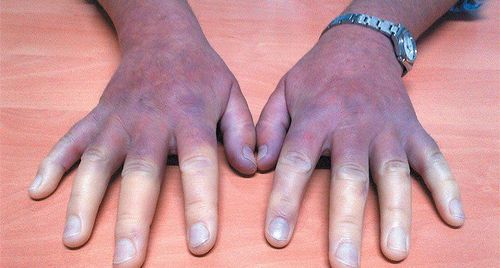This is an automatically translated article.
Mononeuropathy is damage to a nerve, usually a nerve near the skin and near the bone. One of the best known forms of mononeuropathy is carpal tunnel syndrome that results in motor impairment.1. What is mononeuropathy?
Mononeuropathy is damage to a single nerve. This damage can cause pain, loss of motion, or numbness.Mononeuropathy refers to damage or dysfunction of a single peripheral nerve, including any of the cranial nerves, spinal nerves, or branches that connect the central nervous system. central nervous system (ie brain and spinal cord) with the whole body.
Most mononeuropathy causes motor and sensory impairment, often affecting the hands, arms, or feet.
2. What nerves can be affected?
Almost any individual nerve in the body can be affected by mononeuropathy. However, nerves that run near the skin or near bones are more likely to be affected. Includes:Medial nerve at the wrist: This causes the most common form of neuritis, carpal tunnel syndrome, The ulnar nerve in the elbow, The afferent nerve in the upper arm, ulnar nerve just below the knee, lateral femoral nerve in the leg.
3. What is the difference between mononeuropathy and polyneuropathy?
The key difference between mononeuropathy and polyneuropathy is that mononeuropathy refers to the damage of one nerve, whereas polyneuropathy refers to damage of many nerves. .However, both are types of peripheral neuropathy. The accumulation of multiple mononeuropathy, known as polyneuropathy, can sometimes be difficult to distinguish from polyneuropathy.
4. Who is at risk of mononeuropathy?
Anyone can be affected by this pathology. Any nerve with prolonged compression or other stress can be affected.People with certain medical conditions such as diabetes may be at higher risk for sciatica.

Bất cứ ai cũng có nguy cơ mắc bệnh đơn dây thần kinh
5. Causes of mononeuropathy
Mononeuropathy usually results from local nerve damage due to compression-related events that are classified as either fixed or transient.Fixed mononeuropathy is primarily caused by nerve compression on a hard surface, such as a tumor, cast, or even prolonged cramped posture (eg, during hospitalization. or surgery). As a result, there may be changes in sensation, and sometimes movement, of the affected area.
Fixed mononeuropathy most often affects superficial nerves such as: the afferent nerve, extending along the forearm or the dorsal nerve, extending to the lower leg. Fixed mononeuropathy is more commonly noticed in very thin individuals, as direct compression of the nerves on the bone can lead to this condition.
Constant pressure that causes fixed neuropathies can gradually thin the myelin sheath, the protective sheath of nerves, through a process called segmental demyelination. If the pressure is prolonged, it can cut through the myelin sheath and damage the axon. This is called Wallerian degeneration and it can also happen from local trauma, like a deep cut through a nerve.
In addition, the compression of nerves in the narrow anatomical space can cause fixed neuropathies. For example, carpal tunnel syndrome describes when the median nerve becomes trapped and cubital tunnel syndrome is when the ulnar nerve becomes trapped. Many risk factors can lead to a nerve becoming trapped within a restrictive anatomical structure, including pregnancy and hypothyroidism (i.e. low thyroid hormone levels), as well as rheumatoid arthritis, which causes swelling and stiffness of the affected joints.
In contrast to fixed mononeuropathy, transient mononeuropathy is triggered by repetitive actions that cause trauma, such as active muscle activity or a sudden increase in muscle pressure.
Infections localized to an individual nerve, such as herpes zoster, can also lead to neuropathic pain.
6. Symptoms of mononeuropathy
Some clinical manifestations of mononeuropathy may be sudden and very painful, while others may manifest gradually and increase over time.Transient mononeuropathy shows symptoms that are only apparent when the initial movement damages the nerve, whereas symptoms of fixed mononeuropathy are more persistent.
Mononeuropathy can also cause pain, which feels like a stabbing or burning sensation. Motor symptoms, including any movement-related changes, are often present with mononeuropathy. These symptoms include weakness or atrophy, and loss of muscle mass in the affected area.
7. How is mononeuropathy diagnosed?
When diagnosing mononeuropathy, a review of the medical history and physical examination, including extensive neurological evaluation, are necessary.A review of symptoms and physical findings may suggest specific mononeuropathy, but if the clinical diagnosis is inconclusive, further investigation is warranted.
Diagnostic electrodiagnostic test - a method of evaluating the electrical activity of muscles and nerves, often suggested to help reveal conditions that cannot be detected by physical examination alone. The method also provides the ability to locate nerve damage, assess its severity, and estimate prognosis.
8. Treatment of mononeuropathy?
To treat mononeuropathy, it is important to diagnose and treat its underlying cause. For most mononeuropathy presenting with mild symptoms, symptoms can usually resolve with adequate rest, heat, avoidance or elimination of the causative activity, and moderate use of medications. non-steroidal anti-inflammatory drugs (NSAIDs).In certain cases, immobilizing the affected area with a medical device, such as a brace, may improve symptoms. In addition, oral or injectable corticosteroids and therapeutic ultrasound may be recommended to relieve pain, increase circulation, and improve mobility.

Cần phải định nguyên nhân bệnh đơn dây thần kinh để điều trị có hiệu quả
In cases where conservative treatments cannot resolve the associated condition, surgical decompression may be required. For example, when external pressure from a tumor is pressing on a nerve, surgery is the only way to relieve any symptoms. Notably, surgical procedures should also be considered in cases of progressive neuropathy despite conservative management.
In summary, mononeuropathy most often occurs in the superficial branches of the nerve and is often seen in the hands and feet with symptoms such as hand numbness, muscle atrophy, and weakness. Treatment largely depends on the underlying cause and can be conservative in mild cases. In more severe cases where conservative treatments do not resolve symptoms, surgery may be required.
Please dial HOTLINE for more information or register for an appointment HERE. Download MyVinmec app to make appointments faster and to manage your bookings easily.













